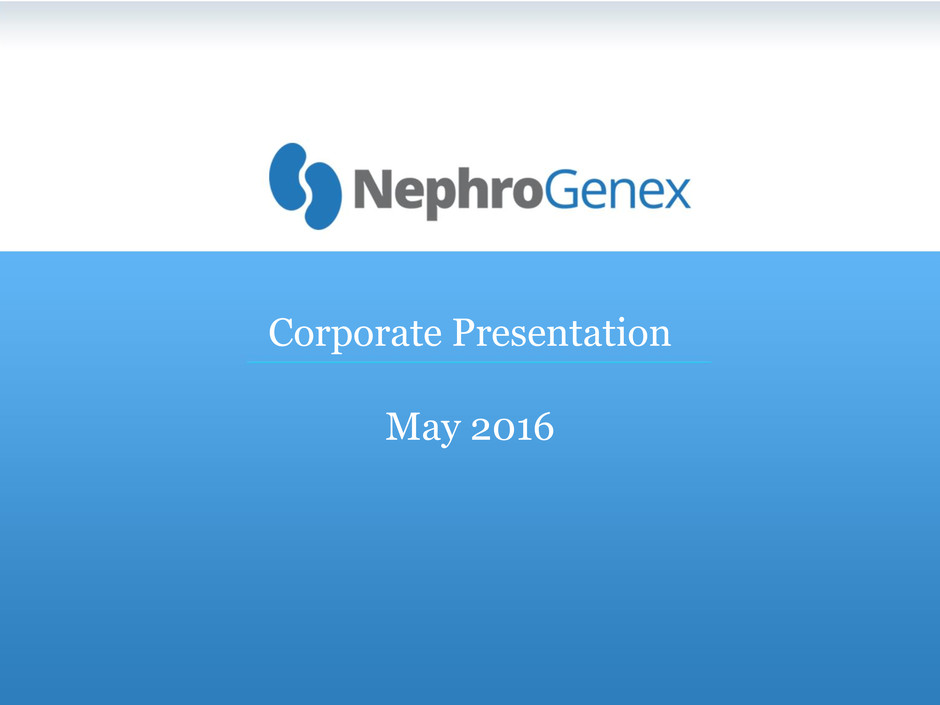
Corporate Presentation May 2016
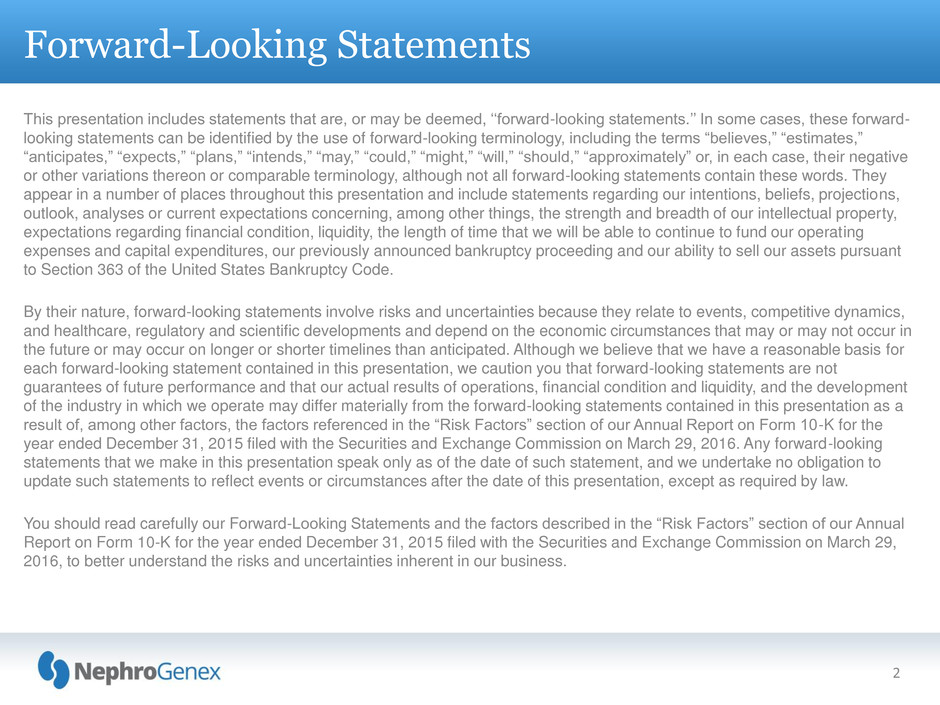
Forward-Looking Statements This presentation includes statements that are, or may be deemed, ‘‘forward-looking statements.’’ In some cases, these forward- looking statements can be identified by the use of forward-looking terminology, including the terms “believes,” “estimates,” “anticipates,” “expects,” “plans,” “intends,” “may,” “could,” “might,” “will,” “should,” “approximately” or, in each case, their negative or other variations thereon or comparable terminology, although not all forward-looking statements contain these words. They appear in a number of places throughout this presentation and include statements regarding our intentions, beliefs, projections, outlook, analyses or current expectations concerning, among other things, the strength and breadth of our intellectual property, expectations regarding financial condition, liquidity, the length of time that we will be able to continue to fund our operating expenses and capital expenditures, our previously announced bankruptcy proceeding and our ability to sell our assets pursuant to Section 363 of the United States Bankruptcy Code. By their nature, forward-looking statements involve risks and uncertainties because they relate to events, competitive dynamics, and healthcare, regulatory and scientific developments and depend on the economic circumstances that may or may not occur in the future or may occur on longer or shorter timelines than anticipated. Although we believe that we have a reasonable basis for each forward-looking statement contained in this presentation, we caution you that forward-looking statements are not guarantees of future performance and that our actual results of operations, financial condition and liquidity, and the development of the industry in which we operate may differ materially from the forward-looking statements contained in this presentation as a result of, among other factors, the factors referenced in the “Risk Factors” section of our Annual Report on Form 10-K for the year ended December 31, 2015 filed with the Securities and Exchange Commission on March 29, 2016. Any forward-looking statements that we make in this presentation speak only as of the date of such statement, and we undertake no obligation to update such statements to reflect events or circumstances after the date of this presentation, except as required by law. You should read carefully our Forward-Looking Statements and the factors described in the “Risk Factors” section of our Annual Report on Form 10-K for the year ended December 31, 2015 filed with the Securities and Exchange Commission on March 29, 2016, to better understand the risks and uncertainties inherent in our business. 2
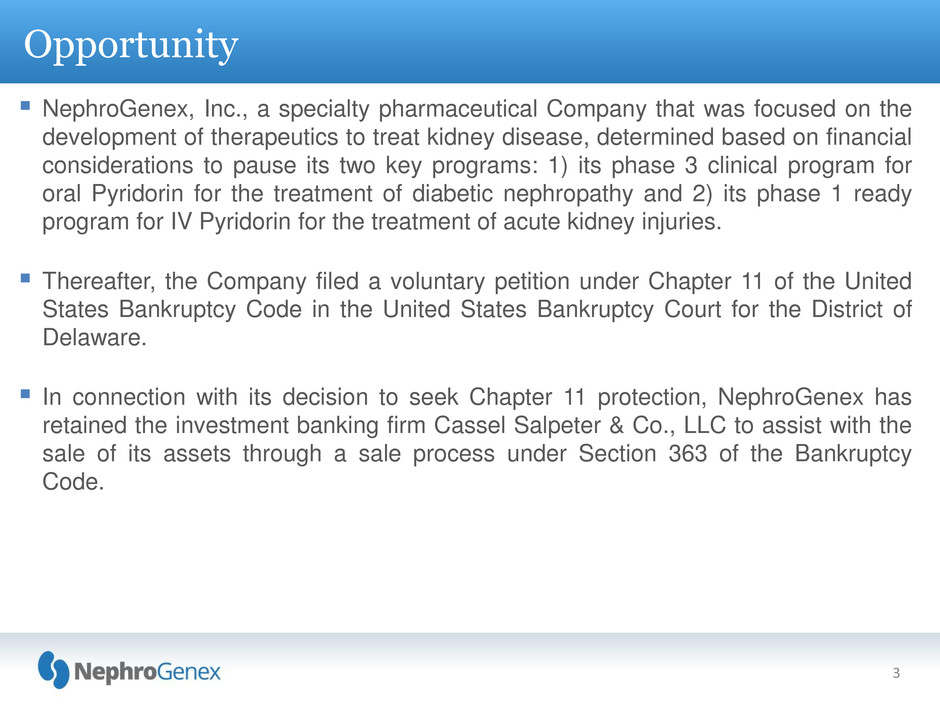
Opportunity 3 NephroGenex, Inc., a specialty pharmaceutical Company that was focused on the development of therapeutics to treat kidney disease, determined based on financial considerations to pause its two key programs: 1) its phase 3 clinical program for oral Pyridorin for the treatment of diabetic nephropathy and 2) its phase 1 ready program for IV Pyridorin for the treatment of acute kidney injuries. Thereafter, the Company filed a voluntary petition under Chapter 11 of the United States Bankruptcy Code in the United States Bankruptcy Court for the District of Delaware. In connection with its decision to seek Chapter 11 protection, NephroGenex has retained the investment banking firm Cassel Salpeter & Co., LLC to assist with the sale of its assets through a sale process under Section 363 of the Bankruptcy Code.

NephroGenex Pipeline Clinical Program Clinical Program / Indication Preclinical Phase 1 Phase 2 Phase 3 Worldwide Commercial Rights ORAL PYRIDORIN ® Diabetic Nephropathy I.V. PYRIDORIN ® Acute Kidney Injury Chronic oral dosing that targets the underlying metabolic pathophysiology of diabetic nephropathy I.V. formulation for hospital use that targets oxidative and carbonyl stress in AKI 4

Oral Pyridorin – Significant Market Potential 5 Diabetic nephropathy progresses from microalbuminuria to macroalbuminuria, then to end stage renal disease (ESRD) and dialysis Estimated 31 million diabetics in the U.S. – 22 million diagnosed, 40% of whom exhibit kidney disease (France, Germany, and U.K. are estimated to have 18 million diabetic patients; 12 million diagnosed) 1.5 million macroalbuminuria, or overt nephropathy (NRX’s indication); 6.9 million microalbuminuria and; 3.2 million additional patients are at high risk of progressing to DN Diabetic nephropathy is a significant healthcare financial burden DN patients progressing toward dialysis estimated to cost approximately $88,000 per patient per year Current approved therapies only partially effective Only ACEIs & ARBs approved for DN; they do not treat the underlying metabolic cause of the disease A significant unmet medical need remains for treatments that can slow or halt DN Potential for significant worldwide revenues Estimated peak sales in the U.S. for macroalbuminuria to be ~ $1 billion (estimated peak sales in EU5 at ~ $100M) Could potentially treat 11.6 million patients in the U.S.
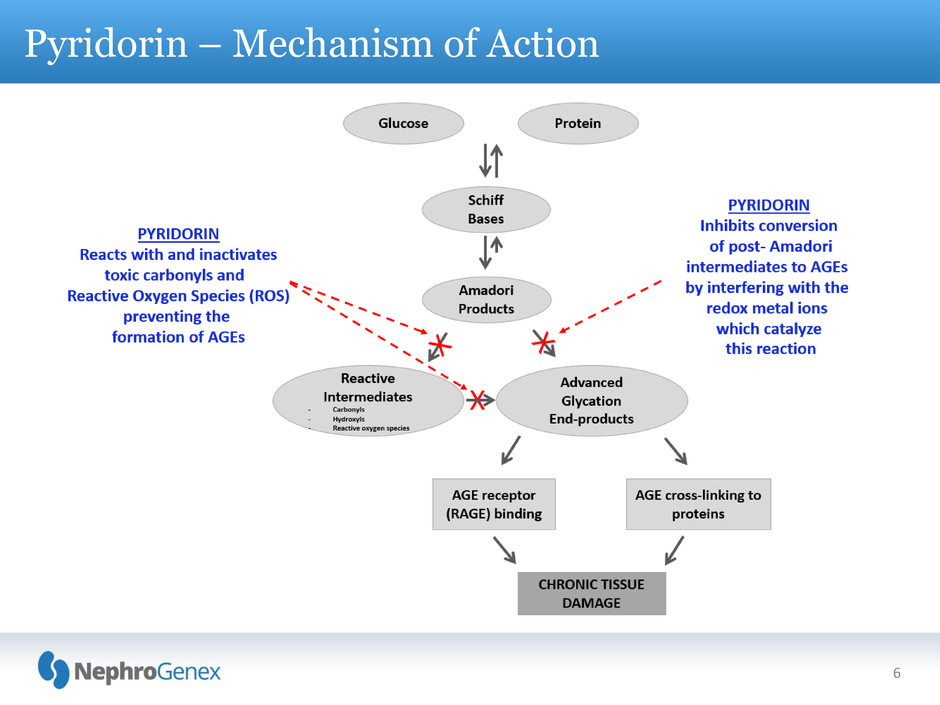
6 Pyridorin – Mechanism of Action

7 Clinical Overview: Ph2 Data in Target Ph3 Population (Type 2 Diabetes; SCr 1.3-3 mg/dL; Urinary Protein >1200 mg/g Cr; Stable SOC) PYR-210 (52 Wk PIVOTAL Ph 2b Study) PYR-206 PYR-205/207 (26 Wk Phase 2a Studies)
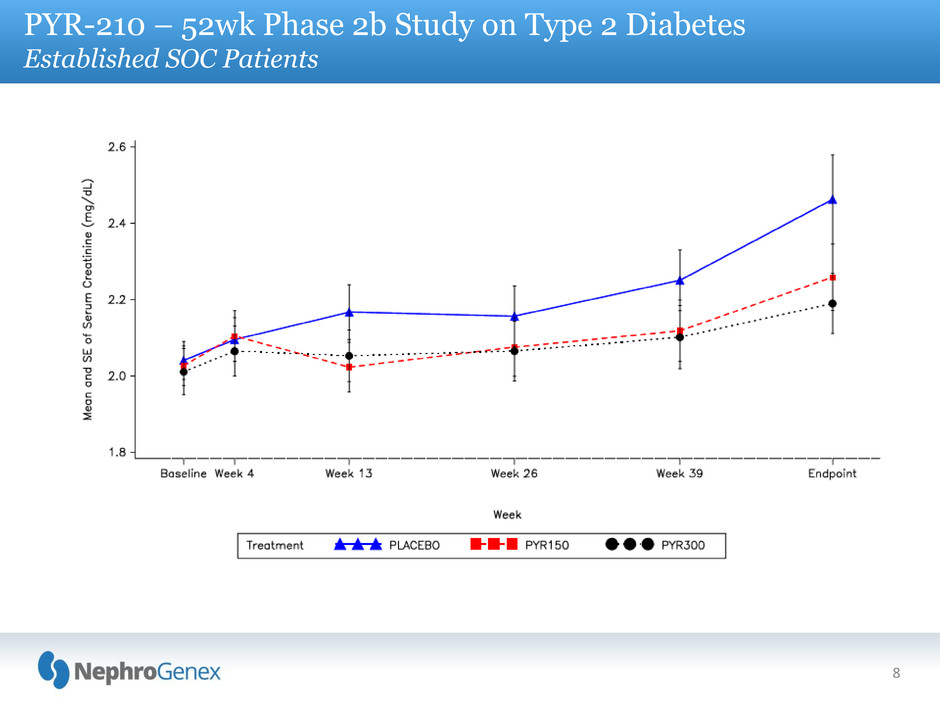
PYR-210 – 52wk Phase 2b Study on Type 2 Diabetes Established SOC Patients 8
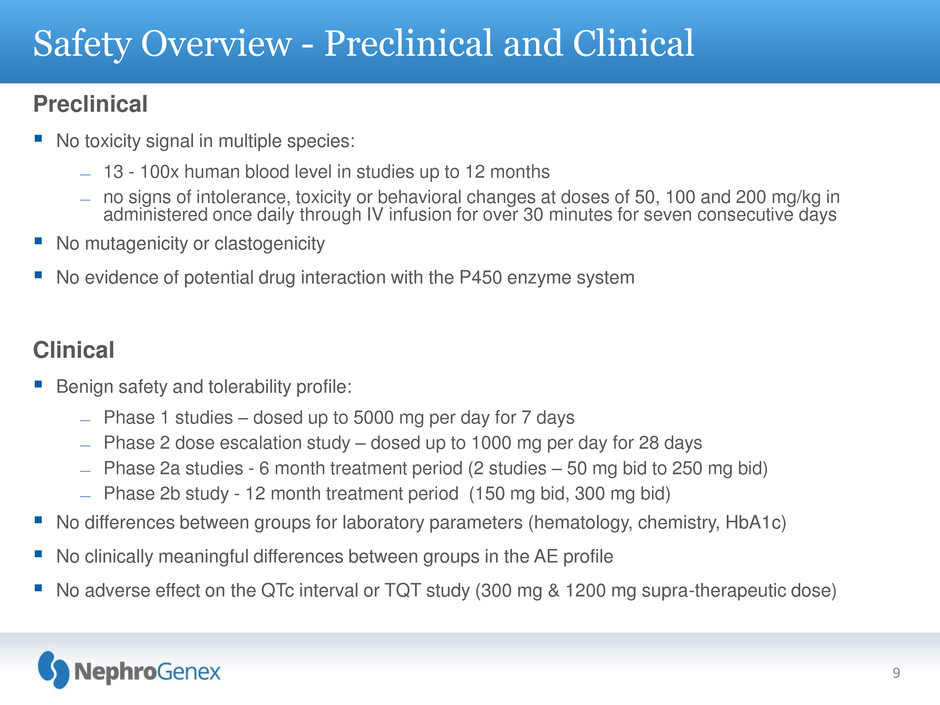
9 Preclinical No toxicity signal in multiple species: ― 13 - 100x human blood level in studies up to 12 months ― no signs of intolerance, toxicity or behavioral changes at doses of 50, 100 and 200 mg/kg in administered once daily through IV infusion for over 30 minutes for seven consecutive days No mutagenicity or clastogenicity No evidence of potential drug interaction with the P450 enzyme system Clinical Benign safety and tolerability profile: ― Phase 1 studies – dosed up to 5000 mg per day for 7 days ― Phase 2 dose escalation study – dosed up to 1000 mg per day for 28 days ― Phase 2a studies - 6 month treatment period (2 studies – 50 mg bid to 250 mg bid) ― Phase 2b study - 12 month treatment period (150 mg bid, 300 mg bid) No differences between groups for laboratory parameters (hematology, chemistry, HbA1c) No clinically meaningful differences between groups in the AE profile No adverse effect on the QTc interval or TQT study (300 mg & 1200 mg supra-therapeutic dose) Safety Overview - Preclinical and Clinical 9

Objective: Evaluate safety and efficacy of Pyridorin at a 300 mg twice daily dose compared to placebo to reduce the rate of renal disease progression due to type 2 diabetes mellitus Patient Population: Type 2 diabetic subjects Baseline SCr >1.3 and <3.0 mg/dL (eGFR > 20 ml/min) Protein/creatinine ratio (PCR) of at least 1200 mg/g Stable dose of ACEI/ARB for 6 months Overall Trial Design 600 patients with overt diabetic nephropathy at approximately 150 centers worldwide Event-driven trial with an estimated duration of approximately 3.5 years Powering 90% powering to detect a 28% treatment effect (57% treatment effect observed in Phase 2b study in similar patient population) Endpoint: Time to a 50% SCr increase or ESRD Overview of Phase 3 Study - PIONEER 10
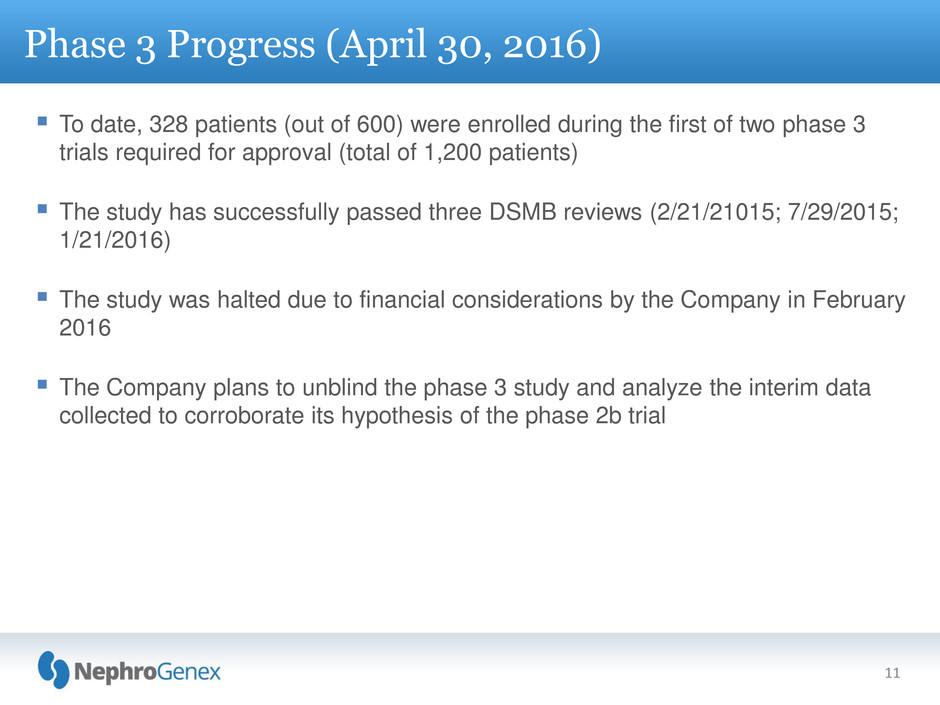
11 Phase 3 Progress (April 30, 2016) To date, 328 patients (out of 600) were enrolled during the first of two phase 3 trials required for approval (total of 1,200 patients) The study has successfully passed three DSMB reviews (2/21/21015; 7/29/2015; 1/21/2016) The study was halted due to financial considerations by the Company in February 2016 The Company plans to unblind the phase 3 study and analyze the interim data collected to corroborate its hypothesis of the phase 2b trial

12 Review the statistical analysis plan with statistician prior to unblinding the data. Proposed data analysis to include: Mean change from baseline in SCr at 6 months, 9 months & 12 months: ― Pyridorin vs placebo ― ITT analysis Sensitivity analysis: ― Per-protocol analysis ― Impact of outliers (SCr > 6mg/dl). ― Baseline SCr ≤2.0 mg/dl or bSCr >2.0 mg/dl, ― Baseline SCr tertiles, Rate of change (slope) of SCr: ― Day 0 to 9 months ― Day 0 to 12 months ― Month 3 to month 12 Responder analysis of SCr: ― 50% change from baseline at 6 months, 9 months and 12 months ― 35% change from baseline at 6 months, 9 months and 12 months Review the 8 adjudicated primary end point events (time to 50% increase in SCr/ESRD) accrued up till trial termination PYR-311 – Proposed Statistical Analysis Nb: this analysis will be regarded as a post-hoc analysis
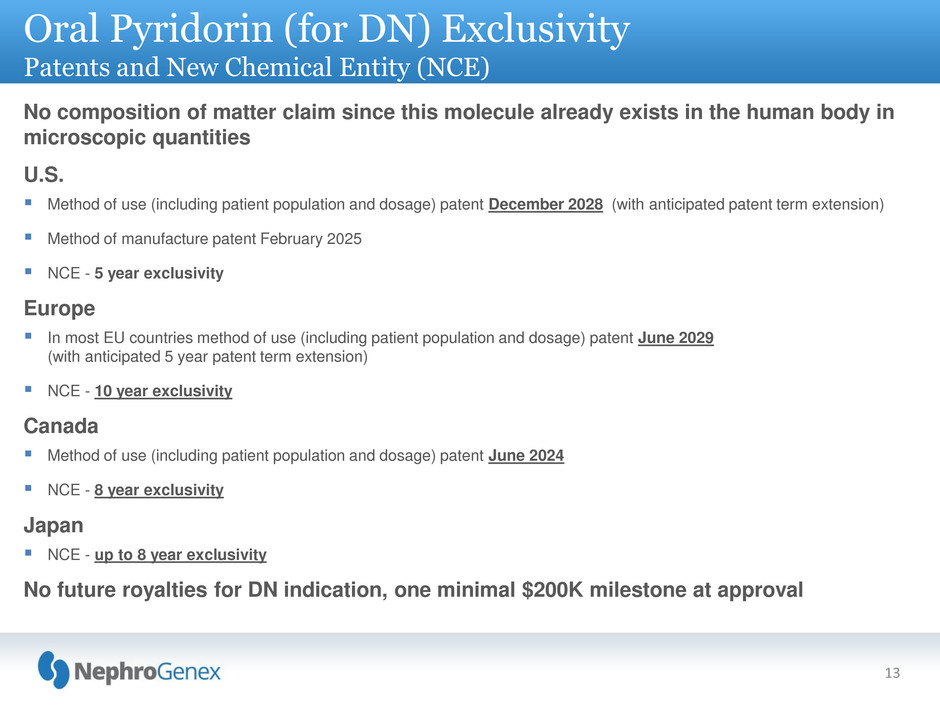
No composition of matter claim since this molecule already exists in the human body in microscopic quantities U.S. Method of use (including patient population and dosage) patent December 2028 (with anticipated patent term extension) Method of manufacture patent February 2025 NCE - 5 year exclusivity Europe In most EU countries method of use (including patient population and dosage) patent June 2029 (with anticipated 5 year patent term extension) NCE - 10 year exclusivity Canada Method of use (including patient population and dosage) patent June 2024 NCE - 8 year exclusivity Japan NCE - up to 8 year exclusivity No future royalties for DN indication, one minimal $200K milestone at approval 13 Oral Pyridorin (for DN) Exclusivity Patents and New Chemical Entity (NCE)
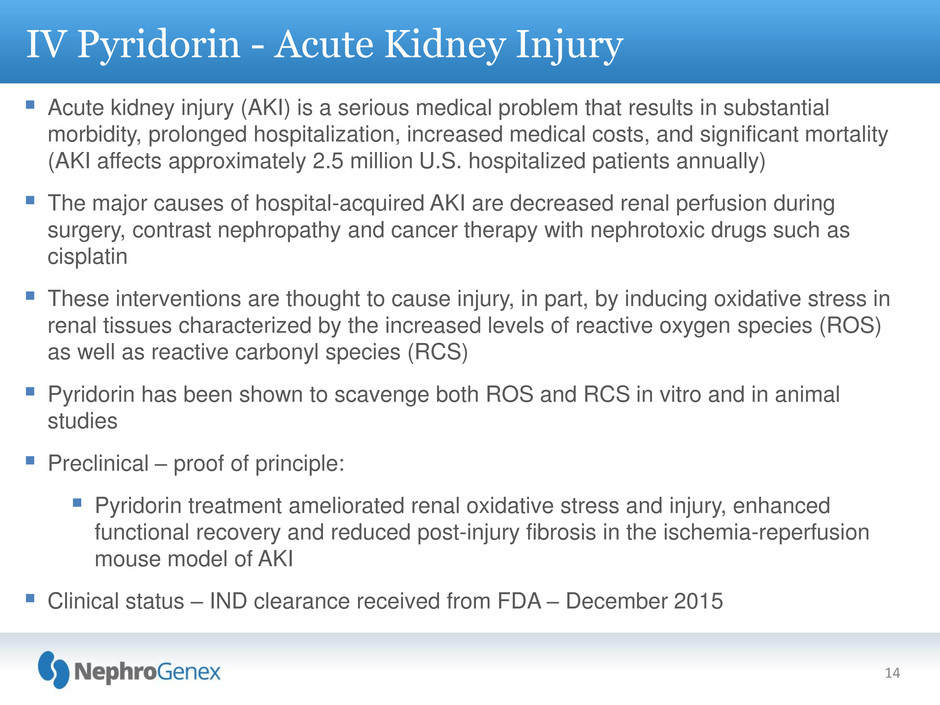
Acute kidney injury (AKI) is a serious medical problem that results in substantial morbidity, prolonged hospitalization, increased medical costs, and significant mortality (AKI affects approximately 2.5 million U.S. hospitalized patients annually) The major causes of hospital-acquired AKI are decreased renal perfusion during surgery, contrast nephropathy and cancer therapy with nephrotoxic drugs such as cisplatin These interventions are thought to cause injury, in part, by inducing oxidative stress in renal tissues characterized by the increased levels of reactive oxygen species (ROS) as well as reactive carbonyl species (RCS) Pyridorin has been shown to scavenge both ROS and RCS in vitro and in animal studies Preclinical – proof of principle: Pyridorin treatment ameliorated renal oxidative stress and injury, enhanced functional recovery and reduced post-injury fibrosis in the ischemia-reperfusion mouse model of AKI Clinical status – IND clearance received from FDA – December 2015 IV Pyridorin - Acute Kidney Injury 14
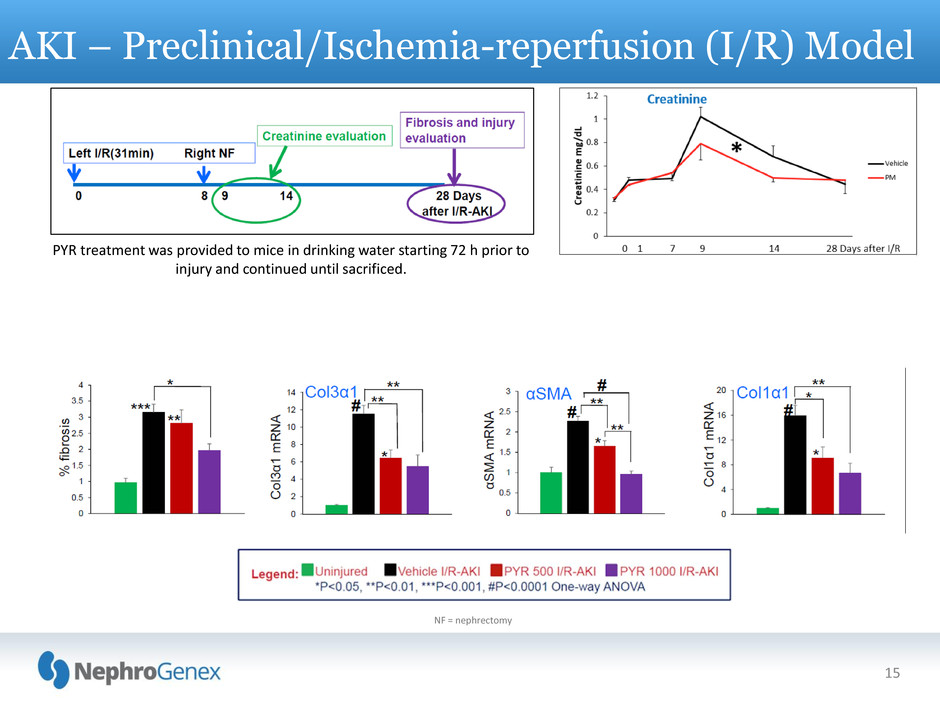
15 PYR treatment was provided to mice in drinking water starting 72 h prior to injury and continued until sacrificed. AKI – Preclinical/Ischemia-reperfusion (I/R) Model NF = nephrectomy

16 Methods for treating or limiting development of AKI Patent Exclusivity Pending first U.S. non-provisional application that, if issued as a patent, would expire in October 2026 absent any patent term adjustment/extension Pending second family of applications with currently pending U.S. and PCT (Patent Cooperation Treaty) non-provisional applications that, if issued as a patent, would expire in November 2035 absent any patent term adjustment/extension Both patent families in-licensed from Vanderbilt University Non-Patent Exclusivity Potential in the U.S. for 3 years of New Clinical Entity (NCE) exclusivity IV Pyridorin for AKI Exclusivity

Summary of Phase 2 Data

PYR-206 (Safety & Tolerability Efficacy not pre-specified) PYR-205/7 (Dose Escalation) Phase 2a Studies - 26 Wk in Type 1 & 2 Diabetic Subjects With Mild/Moderate Nephropathy 18
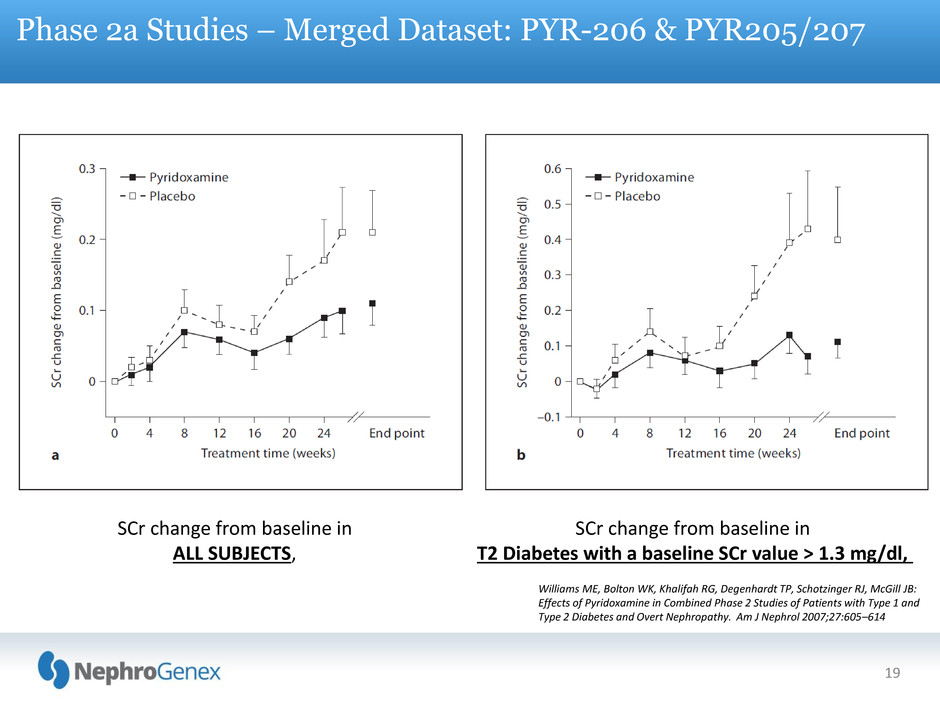
19 Phase 2a Studies – Merged Dataset: PYR-206 & PYR205/207 Williams ME, Bolton WK, Khalifah RG, Degenhardt TP, Schotzinger RJ, McGill JB: Effects of Pyridoxamine in Combined Phase 2 Studies of Patients with Type 1 and Type 2 Diabetes and Overt Nephropathy. Am J Nephrol 2007;27:605–614 SCr change from baseline in ALL SUBJECTS, SCr change from baseline in T2 Diabetes with a baseline SCr value > 1.3 mg/dl,
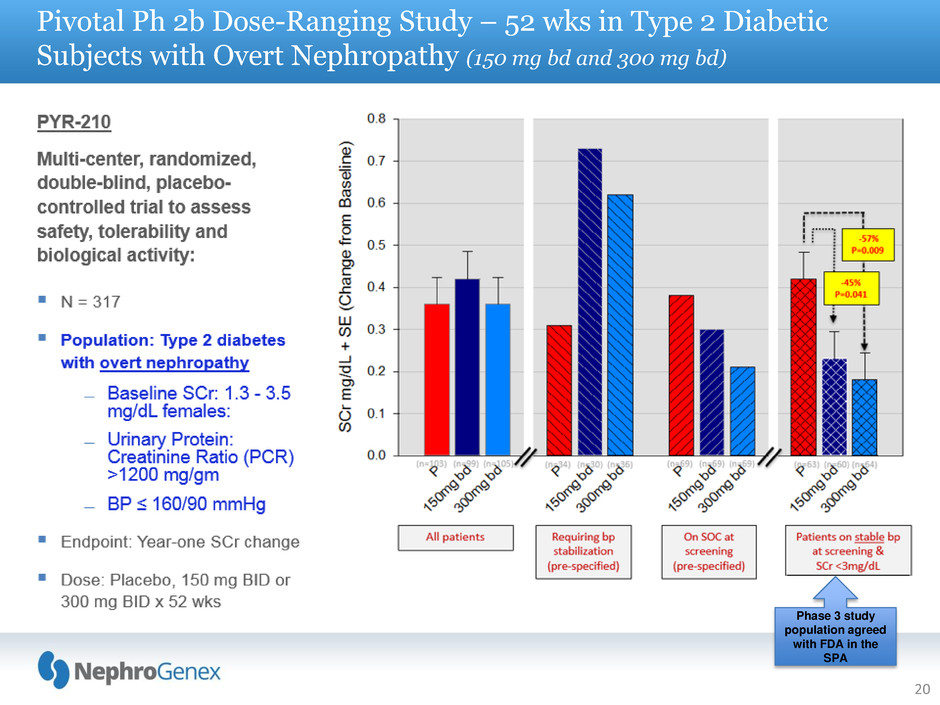
20 Pivotal Ph 2b Dose-Ranging Study – 52 wks in Type 2 Diabetic Subjects with Overt Nephropathy (150 mg bd and 300 mg bd) Phase 3 study population agreed with FDA in the SPA

21 The FDA is aware of this observed effect of possible acute changes in SCr arising from ACEi/ARB/BP medication changes that could impact the SCr baseline and SCr-based calculated treatment effects. A pre-specified analysis was included in the Phase 2b Statistical Analysis Plan to evaluate the adequacy of an 8 week stabilization period on the year-one SCr change endpoint. PYR-210 indicated that a 8-week run-in period was not adequate to establish a stable baseline These data established the basis for the FDA agreed study population for Phase 3. Importance of Stable Standard of Care in DN trials
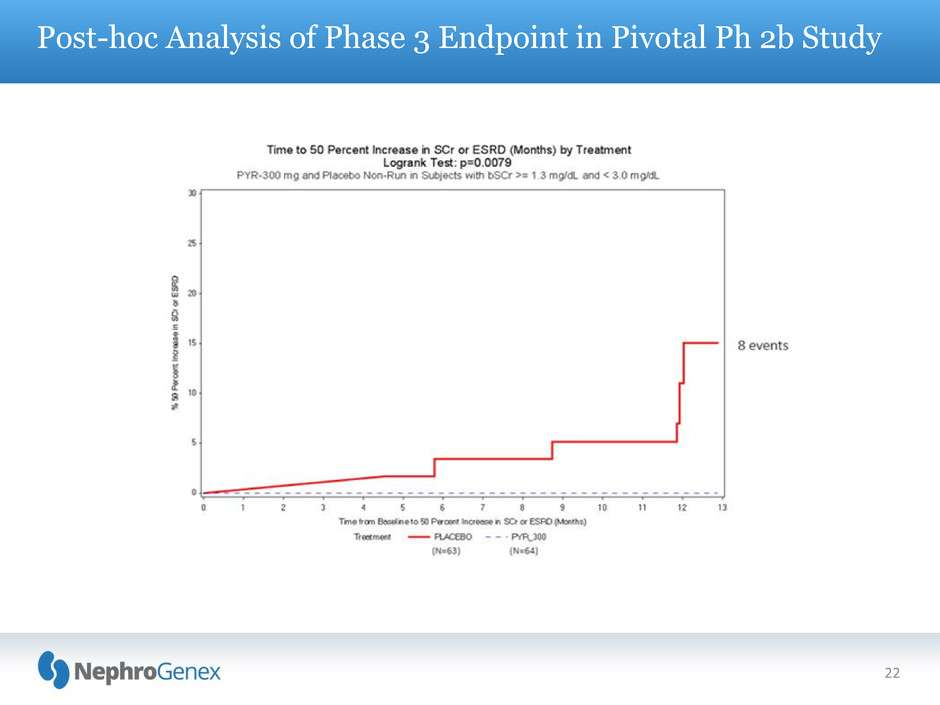
22 Post-hoc Analysis of Phase 3 Endpoint in Pivotal Ph 2b Study
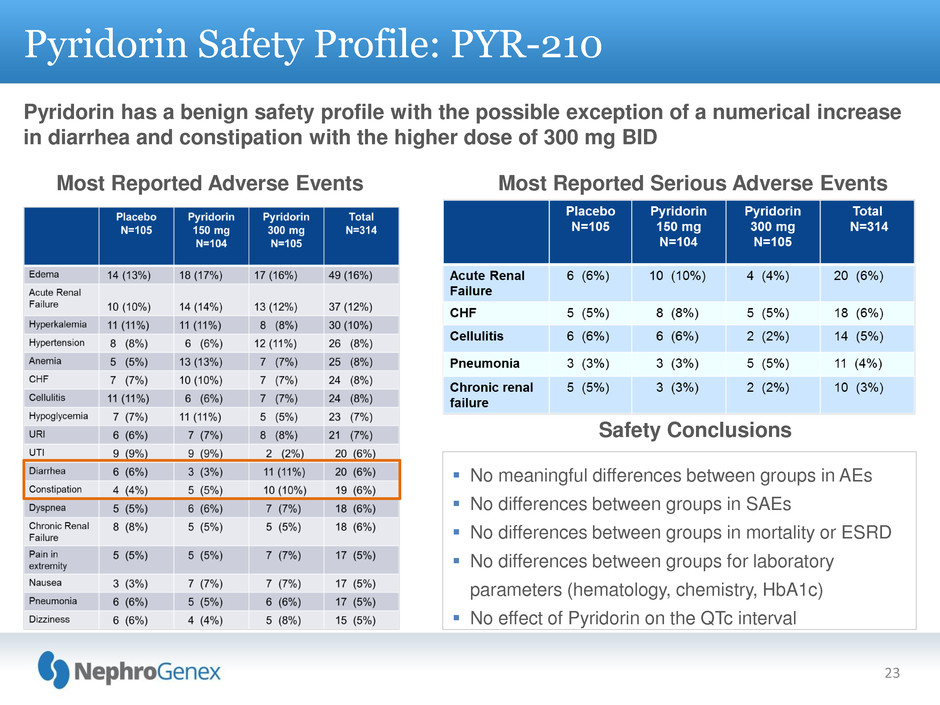
Pyridorin has a benign safety profile with the possible exception of a numerical increase in diarrhea and constipation with the higher dose of 300 mg BID Pyridorin Safety Profile: PYR-210 23 Most Reported Adverse Events Most Reported Serious Adverse Events No meaningful differences between groups in AEs No differences between groups in SAEs No differences between groups in mortality or ESRD No differences between groups for laboratory parameters (hematology, chemistry, HbA1c) No effect of Pyridorin on the QTc interval Safety Conclusions
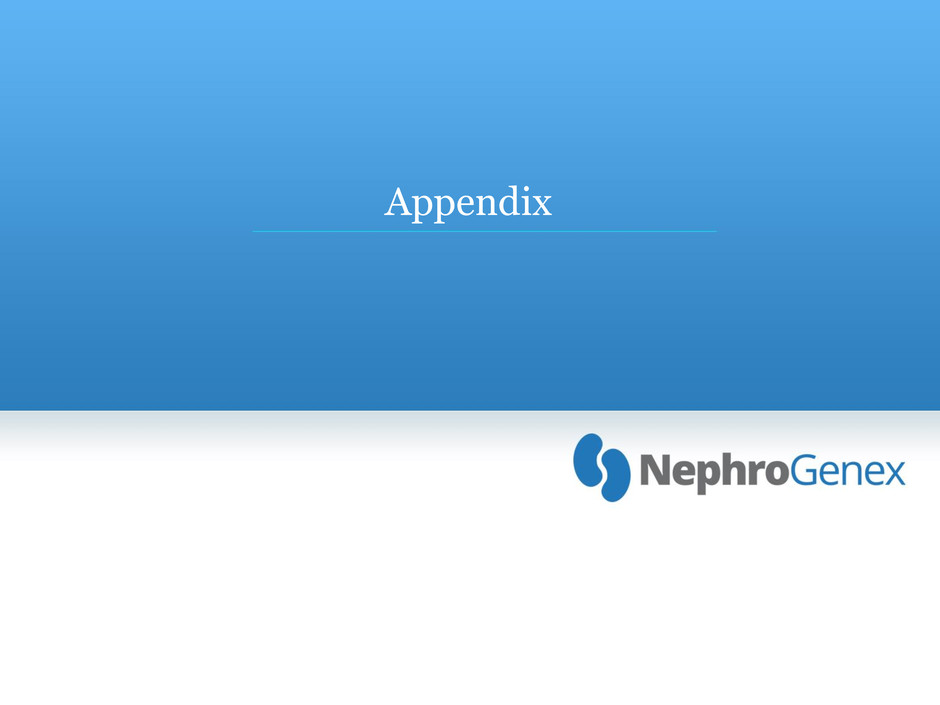
Appendix

Definition Serum Creatinine (SCr) – the level of creatinine, a by-product of muscle metabolism, circulating in the blood Estimated Glomerular Filtration Rate (eGFR) – an estimate of the rate that the glomerulus filters blood based on circulating SCr levels corrected for age, sex, and race Comparison For the average patient recruited to PYR-311: Serum Creatinine and eGFR 25 When SCr, Then eGFR Comparative Change 1 Estimated GFR calculated using MDRD equation SCr Increase eGFR1 Decline 100% 56% 54% 40% 50% 38% 35% 30%
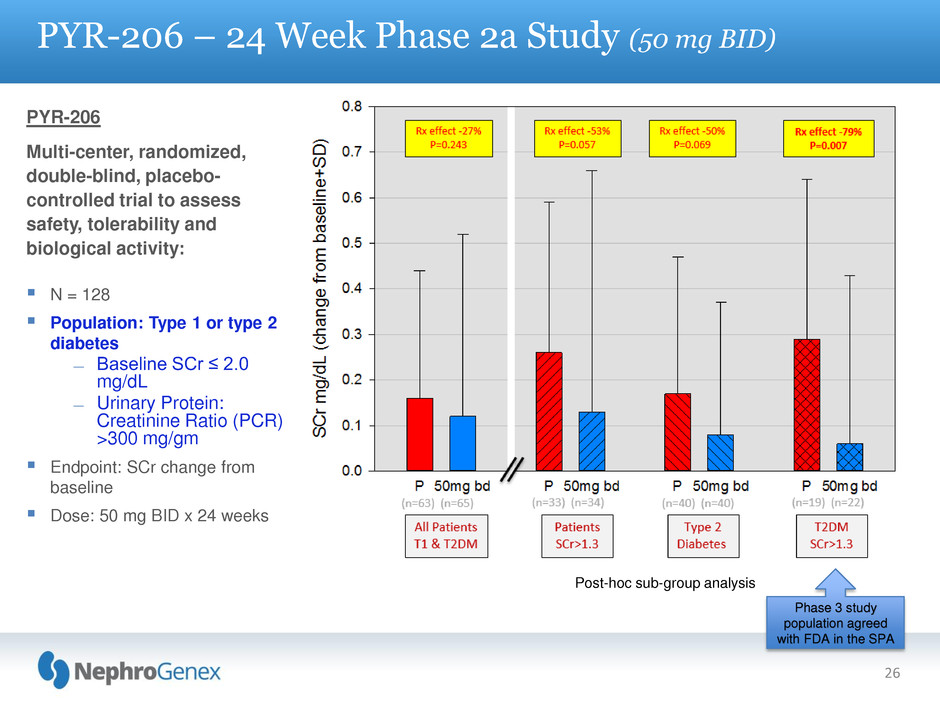
26 PYR-206 – 24 Week Phase 2a Study (50 mg BID) PYR-206 Multi-center, randomized, double-blind, placebo- controlled trial to assess safety, tolerability and biological activity: N = 128 Population: Type 1 or type 2 diabetes ― Baseline SCr ≤ 2.0 mg/dL ― Urinary Protein: Creatinine Ratio (PCR) >300 mg/gm Endpoint: SCr change from baseline Dose: 50 mg BID x 24 weeks Post-hoc sub-group analysis Phase 3 study population agreed with FDA in the SPA
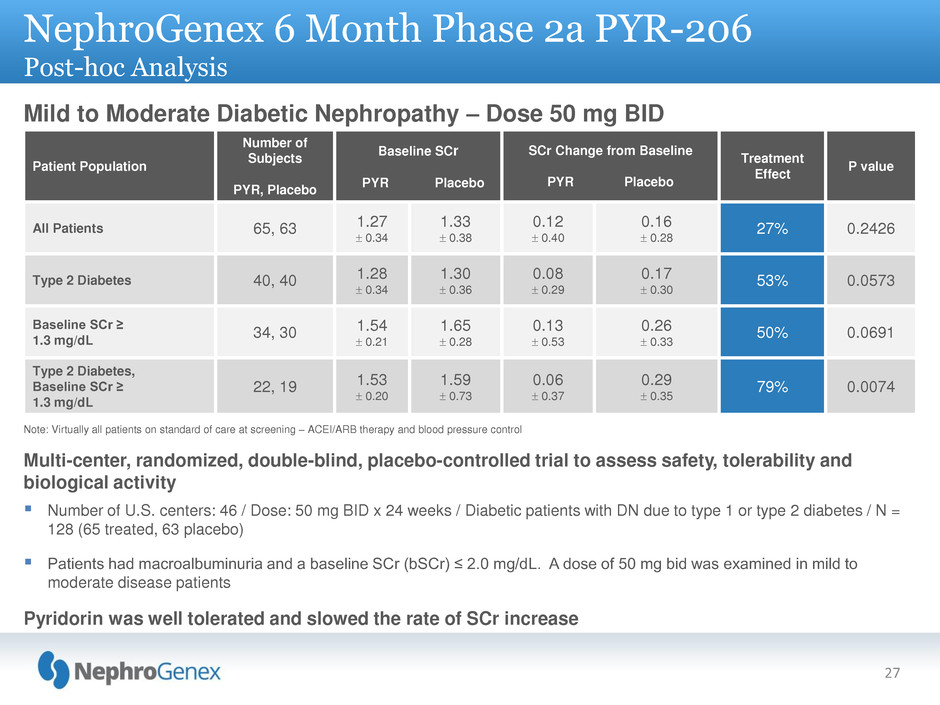
NephroGenex 6 Month Phase 2a PYR-206 Post-hoc Analysis Mild to Moderate Diabetic Nephropathy – Dose 50 mg BID Patient Population Number of Subjects PYR, Placebo Baseline SCr PYR Placebo SCr Change from Baseline PYR Placebo Treatment Effect P value All Patients 65, 63 1.27 0.34 1.33 0.38 0.12 0.40 0.16 0.28 27% 0.2426 Type 2 Diabetes 40, 40 1.28 0.34 1.30 0.36 0.08 0.29 0.17 0.30 53% 0.0573 Baseline SCr ≥ 1.3 mg/dL 34, 30 1.54 0.21 1.65 0.28 0.13 0.53 0.26 0.33 50% 0.0691 Type 2 Diabetes, Baseline SCr ≥ 1.3 mg/dL 22, 19 1.53 0.20 1.59 0.73 0.06 0.37 0.29 0.35 79% 0.0074 Note: Virtually all patients on standard of care at screening – ACEI/ARB therapy and blood pressure control Multi-center, randomized, double-blind, placebo-controlled trial to assess safety, tolerability and biological activity Number of U.S. centers: 46 / Dose: 50 mg BID x 24 weeks / Diabetic patients with DN due to type 1 or type 2 diabetes / N = 128 (65 treated, 63 placebo) Patients had macroalbuminuria and a baseline SCr (bSCr) ≤ 2.0 mg/dL. A dose of 50 mg bid was examined in mild to moderate disease patients Pyridorin was well tolerated and slowed the rate of SCr increase 27
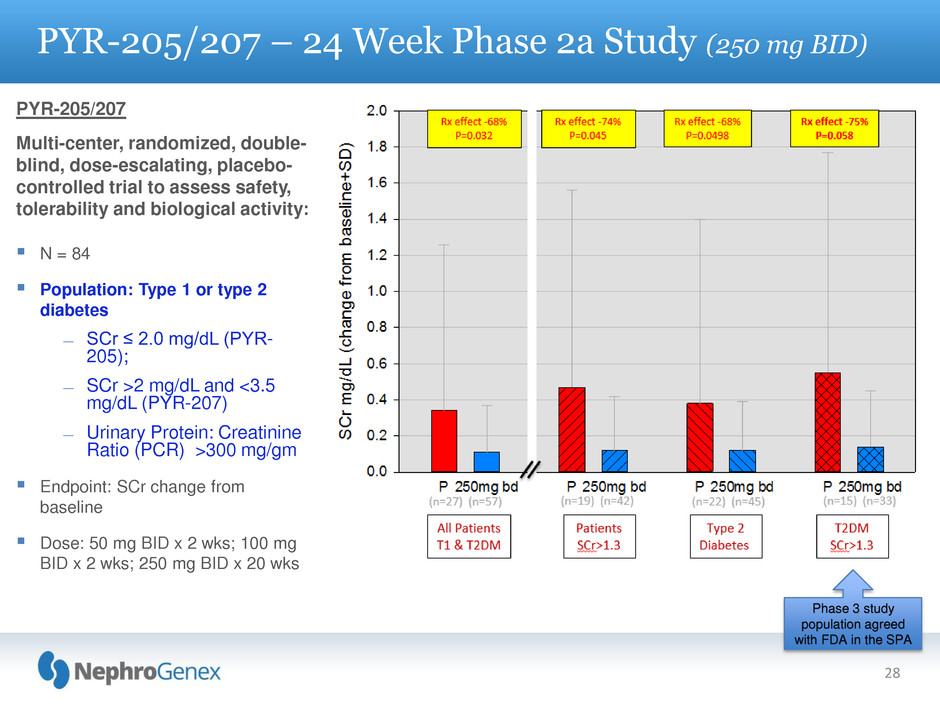
28 PYR-205/207 – 24 Week Phase 2a Study (250 mg BID) PYR-205/207 Multi-center, randomized, double- blind, dose-escalating, placebo- controlled trial to assess safety, tolerability and biological activity: N = 84 Population: Type 1 or type 2 diabetes ― SCr ≤ 2.0 mg/dL (PYR- 205); ― SCr >2 mg/dL and <3.5 mg/dL (PYR-207) ― Urinary Protein: Creatinine Ratio (PCR) >300 mg/gm Endpoint: SCr change from baseline Dose: 50 mg BID x 2 wks; 100 mg BID x 2 wks; 250 mg BID x 20 wks Phase 3 study population agreed with FDA in the SPA
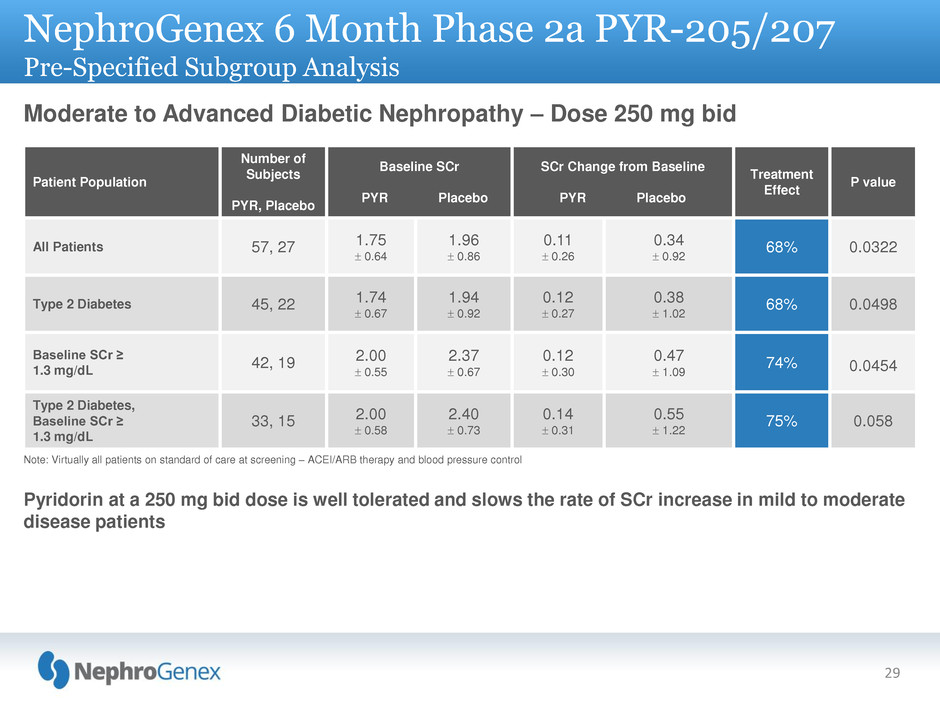
NephroGenex 6 Month Phase 2a PYR-205/207 Pre-Specified Subgroup Analysis Moderate to Advanced Diabetic Nephropathy – Dose 250 mg bid Note: Virtually all patients on standard of care at screening – ACEI/ARB therapy and blood pressure control Pyridorin at a 250 mg bid dose is well tolerated and slows the rate of SCr increase in mild to moderate disease patients 29 Patient Population Number of Subjects PYR, Placebo Baseline SCr PYR Placebo SCr Change from Baseline PYR Placebo Treatment Effect P value All Patients 57, 27 1.75 0.64 1.96 0.86 0.11 0.26 0.34 0.92 68% 0.0322 Type 2 Diabetes 45, 22 1.74 0.67 1.94 0.92 0.12 0.27 0.38 1.02 68% 0.0498 Baseline SCr ≥ 1.3 mg/dL 42, 19 2.00 0.55 2.37 0.67 0.12 0.30 0.47 1.09 74% 0.0454 Type 2 Diabetes, Baseline SCr ≥ 1.3 mg/dL 33, 15 2.00 0.58 2.40 0.73 0.14 0.31 0.55 1.22 75% 0.058
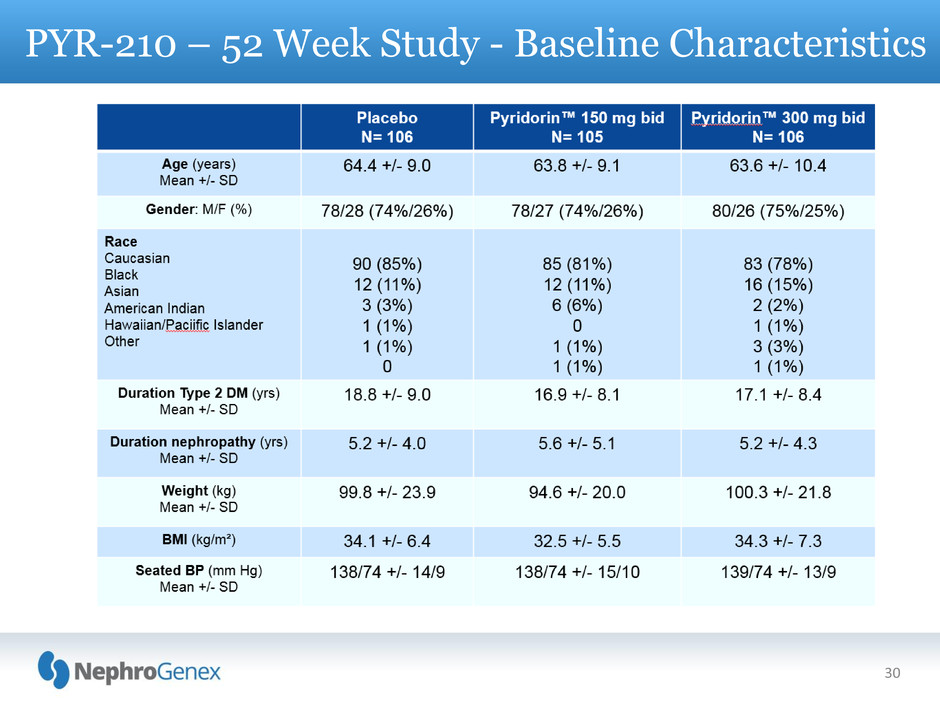
30 PYR-210 – 52 Week Study - Baseline Characteristics
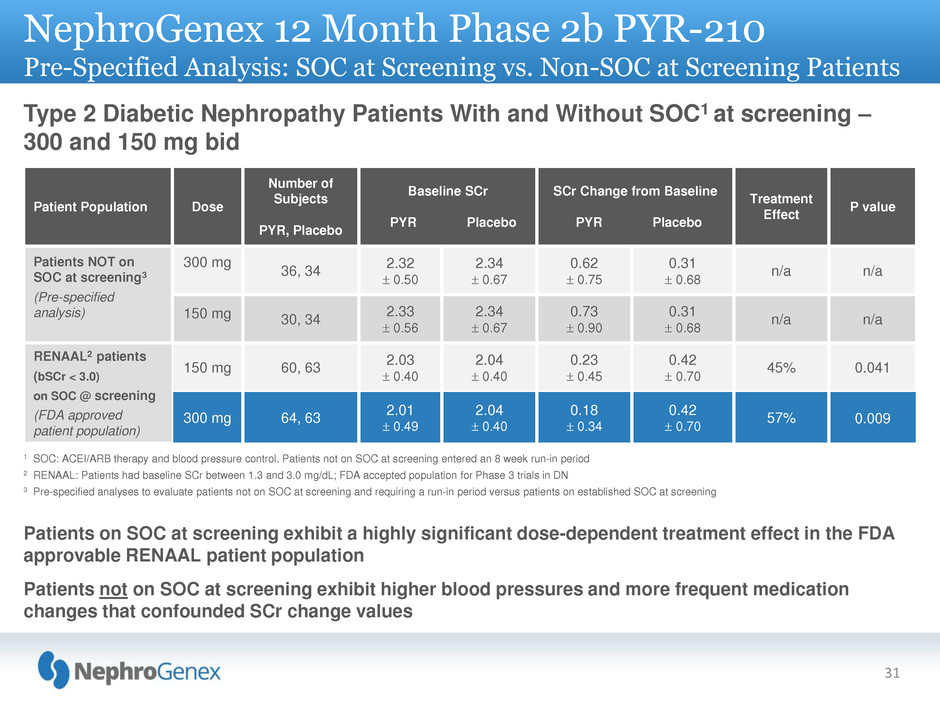
NephroGenex 12 Month Phase 2b PYR-210 Pre-Specified Analysis: SOC at Screening vs. Non-SOC at Screening Patients analysis Type 2 Diabetic Nephropathy Patients With and Without SOC1 at screening – 300 and 150 mg bid 1 SOC: ACEI/ARB therapy and blood pressure control. Patients not on SOC at screening entered an 8 week run-in period 2 RENAAL: Patients had baseline SCr between 1.3 and 3.0 mg/dL; FDA accepted population for Phase 3 trials in DN 3 Pre-specified analyses to evaluate patients not on SOC at screening and requiring a run-in period versus patients on established SOC at screening Patients on SOC at screening exhibit a highly significant dose-dependent treatment effect in the FDA approvable RENAAL patient population Patients not on SOC at screening exhibit higher blood pressures and more frequent medication changes that confounded SCr change values 31 Patient Population Dose Number of Subjects PYR, Placebo Baseline SCr PYR Placebo SCr Change from Baseline PYR Placebo Treatment Effect P value Patients NOT on SOC at screening3 (Pre-specified analysis) 300 mg 36, 34 2.32 0.50 2.34 0.67 0.62 0.75 0.31 0.68 n/a n/a 150 mg 30, 34 2.33 0.56 2.34 0.67 0.73 0.90 0.31 0.68 n/a n/a RENAAL2 patients (bSCr < 3.0) on SOC @ screening (FDA approved patient population) 150 mg 60, 63 2.03 0.40 2.04 0.40 0.23 0.45 0.42 0.70 45% 0.041 300 mg 64, 63 2.01 0.49 2.04 0.40 0.18 0.34 0.42 0.70 57% 0.009

Primary Endpoints: Evaluate Pyridorin 300 mg twice daily (BID) efficacy compared to placebo in reducing the rate of progression of renal disease due to type 2 diabetes mellitus. With time to the composite endpoint consisting of the earliest event amongst: ― A serum creatinine (SCr) increase of ≥50% from baseline, or ― End stage renal disease (ESRD) Key Secondary Endpoints: Time to the composite endpoint event of a SCr increase of ≥100% from baseline or ESRD Safety of Pyridorin compared to placebo, as assessed by adverse events, 12-lead electrocardiograms (ECGs), vital signs, physical examination, clinical chemistries, glycosylated hemoglobin (HbA1c), and hematology Additional secondary objectives of the study (Pyridorin 300 mg BID to placebo) at year 1 and 2: ― Change in SCr from baseline ― Change in serum cystatin-C from baseline ― Change in urine protein/creatinine ratio (PCR) from baseline ― Change in urinary transforming growth factor-beta (TGF-β) excretion from baseline PIONEER Pyridorin Phase 3 Trials Protocol 32 ESRD is defined as the initiation of permanent dialysis, receiving a kidney transplant, or a SCr value ≥ 6.0 mg/dL (528 μmol/L) with a second SCr confirmation value ≥ 6.0 mg/dL (528 μmol/L) obtained 4 – 6 weeks later































